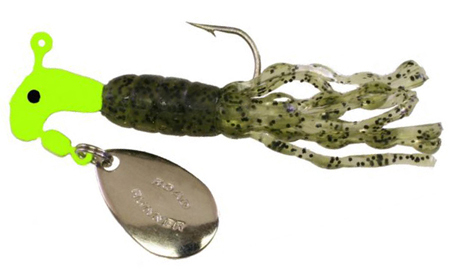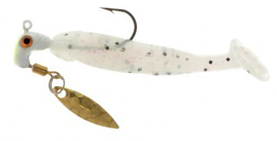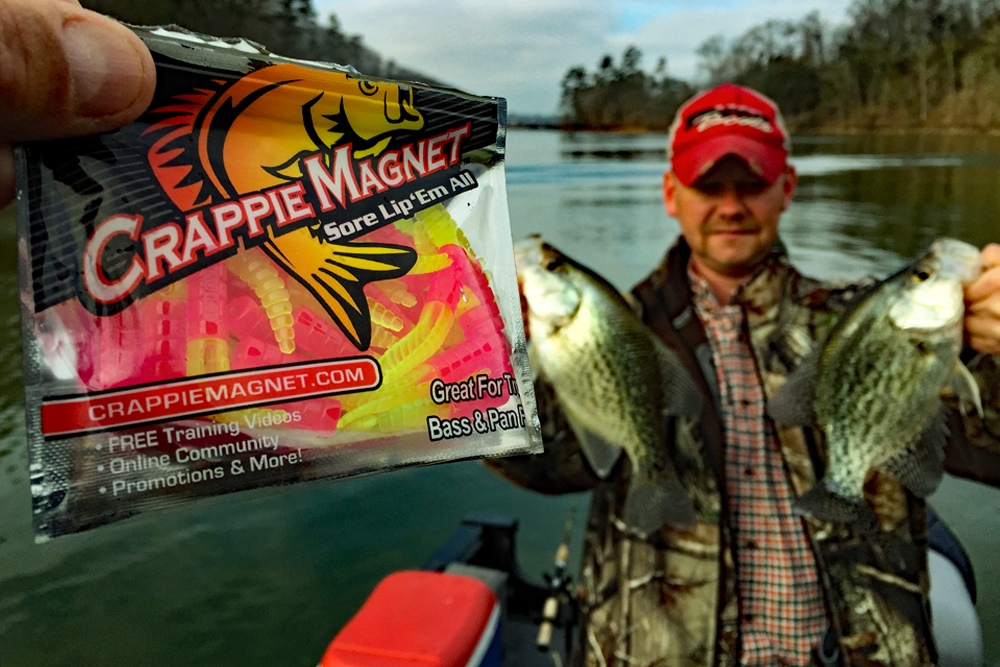Every part of the country seems to have a favorite “go to” color. However nearly every crappie angler in the world will agree that any jig including chartreuse can’t go wrong. (Photo: Richard Simms)
Chasing the Rainbow
How to pick the best color for crappie
by Tim Huffman
Fishermen love to have “secret colors”, those that catch more fish than colors other fishermen are using. That is part of the fun of fishing. A tournament fisherman wants a color bigger crappie hit even if numbers are less. A fisherman who wants food or fun wants more action with more fish in the livewell at the end of the day. Whatever a fisherman’s goal, the purpose is to have more crappie, big and small, bending the pole.
Rule-of-Thumb: Where to Start
Use dark colors in dark conditions. Dark conditions include dark or stained water, dawn, dusk, cloudy skies and night. A dark color is easier for a fish to see because when it looks up, a darker jig creates a better shadow or outline than a light-colored jig. It’s probably more about a crappie seeing the jig than the actual jig color.

Tim Huffman’s suggestions for baits for clear water – first column, top to bottom: Jenko 2” Fry Daddy Blue Moon – Grizzly Jig Dead Ringer Clear Multisparkle – Bobby Garland Baby Shad Monkey Milk Glow – MidSouth Tube, White/Chartreuse. Suggested baits for any water clarity, second column: Jenko Paddle Fry Sunburst – Muddy Water 2.5” Outlaw color – MidSouth Tube Chartreuse Glow – Brushpile Brush Blade Watts Blue Magic. Suggested baits for stained/dingy water, third column: Jenko Paddle Fry Midnight Pink – Muddy Water Black/Glow – Muddy Water Orange/Chartreuse Glow.
Doyle Hudson, owner of MidSouth Tackle, says, “Colors can be complicated. The darker the water, like near bottom, the darker jig you need. It would be like us holding a jig up and looking at it in the moonlight. If the bait is too clear we can’t see it. If it too dark, it doesn’t look real. You have to find the right color for the clarity and light so the bait looks right to the fish.”
Light colors are good in clear water, or in stained waters during bright sunlight. A crappie can see a jig in clear water much easier than in stained. Therefore, the whites, shad, pinks, light blue and other softer colors are usually best.
Slight to moderate stained waters has better light penetration when the sun is bright, so bright colors can also work good during these conditions.
The takeaway: Dark conditions, dark colors; light conditions, light colors.
More Than Black & White
Ron Stallings has been associated with baits all of his life. He grew up working at his father’s bait shot. He has decades working with foreign markets, designs and marketing with TTI-Blakemore, the Roadrunner company, and colors are a critical part of his business.
“Catching fish is about colors but it’s also about passing or blocking light. In dark waters, it’s best to use a dark color like Junebug or black. Use opaque colors that block light and create a bait shadow fish can see in dark water.
 “It’s opposite in clear water. A semi-transparent bait, like a Monkey Milk, will work in most clearer waters and often in stained. It’s a more natural-looking bait because of the color and having some light going through it.”
“It’s opposite in clear water. A semi-transparent bait, like a Monkey Milk, will work in most clearer waters and often in stained. It’s a more natural-looking bait because of the color and having some light going through it.”
The takeaway: Opaque colors in dark water; semi-transparent in clear.
Which Color?
Chartreuse is on everyone’s list. Since nothing in the lake is chartreuse color, it shows that getting bites is more about what a fish can see. A chartreuse bait can be opaque, glow or transparent and it is the number one color to be matched with other colors. Black-chartreuse is a popular color anywhere in the country.
Monkey milk, a milky, sparkly bait, is a great color in most waters, but especially clear lakes. Monkey milk in a shad body looks real. Other good colors include blue/white, white/chartreuse and pink/white. Softer colors are usually best in clearer waters.
Natural colors include pumpkinseed-colored baits. They are good around vegetation including grass, weeds and lily pads.
Experts agree that very dingy or muddy water needs glow colors in orange, black, yellow, and chartreuse. These colors help draw attention to a bait in low-visibility waters.
A good all-around bait for many waters is green/chartreuse glow. Again, it’s an attention-getter without spooking the fish.
The takeaway: Having a good variety of colors is important. Use proper color for conditions but switch as necessary until the best color is found.
Final Notes
Each region of the country has different colors that work. For example, it might be Junebug at Missouri, orange-chartreuse in Kentucky, red-white in the north and greens in Florida. However, black-chartreuse will in the top three of every region. Monkey Milk has climbed the ladder of popularity, too. Red-chartreuse is another popular choice. It’s your job to chase the rainbow and find the best color to put more fish on the end of your line.
Color options are endless with every color having a situation when it will work. Classic Champ Travis Bunting, owner of Muddy Water Baits, says, “Colors are important. However, a fisherman needs to have confidence in the color he is using, especially when fishing gets tough. He must believe the color will work. If not, he will be changing colors and worrying about baits more then getting a jig into the right spots with a good presentation.”


